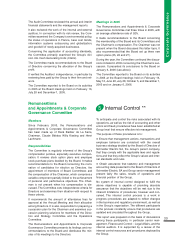APC 2005 Annual Report Download - page 43
Download and view the complete annual report
Please find page 43 of the 2005 APC annual report below. You can navigate through the pages in the report by either clicking on the pages listed below, or by using the keyword search tool below to find specific information within the annual report.
41
The internal audit process complies with international
audit guidelines established by the Institute of Internal
Auditors.
After each internal audit, a report is issued setting out
the auditors’ findings and recommendations. Copies of
the report are given to the head of the audited entity,
Group senior management and the Audit Committee.
The Statutory Auditors also have access to the reports.
In 2005, the internal auditors performed 21 audits,
including:
Full audits of medium-sized units.
Audits of a number of operating processes (pur-
chasing, supply chain, IT, etc.).
Post-acquisition audits for newly acquired compa-
nies.
Analyses of control self-assessments by the units.
d) Finance and Control - Legal Affairs
The Finance and Control – Legal Affairs department is
actively involved in organizing control and ensuring
compliance with procedures.
It is responsible for consolidating and analyzing month-
ly, quarterly and annual financial data.
As part of this mission, the department drafts and
updates statutory and management accounting pro-
cedures (see below) designed to ensure that statuto-
ry and management accounting practices are consis-
tent throughout the Group and in compliance with
applicable regulations.
The Finance and Control – Legal Affairs department
works closely with the board of Auditors. Consolidated
units are audited by one of the two Statutory Auditors
or an auditor from their network.
e) Operating Divisions
The Operating Division management teams play a
critical role in effective internal control. With the excep-
tion of recently acquired companies, all Group units
report to one of the four Operating Divisions, which are
managed by an Executive Vice-President, supported
by a financial controller. Within each division, the man-
agement team organizes control of operations,
ensures that appropriate strategies are deployed to
achieve objectives and tracks unit performance.
The Division Executive Vice-Presidents sit on the
Operations Committee and report to the Chief Operat-
ing Officer. The financial controllers report functionally
to the Finance and Control – Legal Affairs department.
A Management Committee reviews the divisions’
transactions monthly.
This matrix organization guarantees a high level of
responsiveness as concerns operations-related risks,
thanks to local presence, understanding of specific
local requirements, and application of Group guide-
lines, thanks to frequent contacts with the corporate
functions.
f) Human Resources
The Human Resources department is responsible for
deploying and ensuring the application of procedures
concerning employee development, occupational
health and safety and professional ethics. These pro-
cedures are presented to all employees in a document
entitled "Our Principles of Responsibility". Compliance
is verified through the annual evaluation process and
tracking of new2indicators (see "Sustainable Develop-
ment").
Internal benchmarks
a) Principles of Responsibility
The Principles of Responsibility are a set of guidelines
for decisions and actions that have an impact on stake-
holders–employees, customers, suppliers, sharehold-
ers, the community–or the environment. A copy of the
Principles is given to all new employees along with
their employment contract.
b) Insider Code
This code sets out the rules to be followed by manage-
ment and employees to prevent insider trading. It
imposes an obligation of confidentiality on all employ-
ees who have access to price-sensitive information
and sets permanent restrictions on purchases and
sales of Schneider Electric shares by persons who
have access to price-sensitive information in the
course of their work.
c) International Internal Auditing Standards
The Schneider Electric internal auditors are commit-
ted to complying with the international standards pub-
lished by the Institute of Internal Auditors (I.I.A.) and
other bodies.
d) Group management and reporting policies
(see below)
Procedures
a) Operating procedures
Management of operating risks
Operating risks are managed first and foremost by the
units in liaison with the Operating Divisions, based on
Group instructions. General risks are covered by spe-
cific procedures described below.
Commitment limits
Commitment limits have been set for executives from
Group level down to the individual units, whereby con-
tracts for the purchase or sale of products or services
may be signed or authorized only by line management
when they exceed a certain amount which varies
according to the type of contract, up to a maximum of
10 million. In addition all transactions that may affect
the Group's fundamental interests, due to their size or
nature, must be authorized in advance by Group sen-
ior management or, in some cases, the Board of Direc-
tors. This rule applies in particular to all purchases and
sales of shares in subsidiaries and affiliates whatever
the amounts involved, as well as to subscriptions to
share issues by these entities, purchases and sales of
strategic assets, product development, trademarks
and patents, and off-balance sheet commitments.
Corporate Governance
























